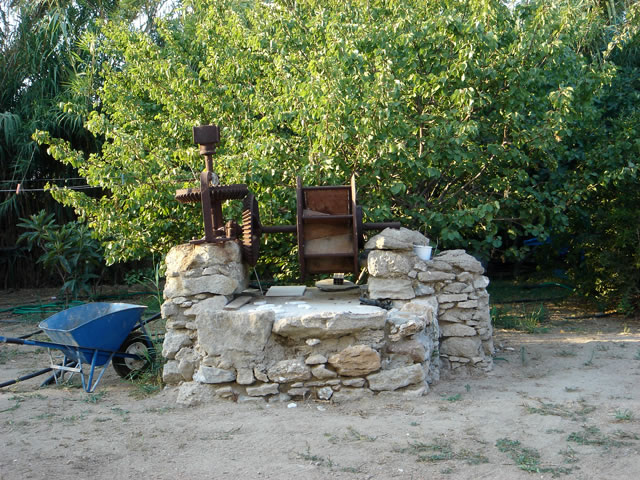Waterworks
Through the years the habitants of the island have invented various interesting mechanisms for drawing water from the wells.
One of these traditional mechanisms was called aerani . This was a quite simple invention, which was used for small quantities of water from shallow wells. It was based on the action – fulcrum – reaction system. A wooden crotch was vertically fixed in the ground at a distance of two or three metres from the well. A horizontal wooden axle was nailed to the wooden crotch, used as a base for another wooden element rotating around the crotch. A heavy rock, tied to one end was used as a counterweight, while on the other end a long cane was fixed, hanging vertically. From this cane a bucket would hang.

Hydria Virtual Museum
In the initial position of this system, the weight of the rock forces the system to stand vertically, with the bucket hanging approximately at the height of the well’s crest. By pulling the cane downwards, the bucket would be immersed into the water of the well. Once the bucket filled with water, the weight of the rock would force the bucket to be lifted to a new position, close to the crest of the well. Then the system would balance and very little force was necessary in order to lift the bucket to the surface and draw the water.
Windlass wells are also popular in many villages of Naxos. The simplest ones consist of a metal cylinder that can be wound manually by a metal crank. The bucket would hang from a rope in the well, fill with water and be lifted up by manually winding this mechanism.
A more complicated windlass system would be used in order to draw larger quantities of water from deeper wells . Initially this type of windlass was brought from Piraeus, but during World War II the inhabitants of Naxos needed to increase the cultivations of their fields to counter famine and so had to ensure much more water for irrigation. Therefore, they had to invent a method whereby they could construct such mechanisms on their own.
The whole system was metal and consisted of three basic parts: (i) the drum, (ii) the cogwheels and (iii) the buckets.

Hydria Virtual Museum
The drum was the central part of the mechanism and it was located and stabilised above the well. It consisted of two circular metal bases connected together by a truncated cone-shaped element. Metal wings were located in the perimeter of this truncated cone-shaped element. The metal cone in the middle of the drum and the wings, also made of metal, can be seen. One circular base of the drum had polygonal holes.
The two cogwheels put the drum in motion. To do this, it was necessary to yoke a mule, whose movement would activate the whole system. The first cogwheel was placed horizontally, beside the drum, and on top of it a long piece of wood of about 3 or 4 m was fixed. The mule would move in circles around the well, dragging the long wood and forcing the first cogwheel to be turned. The horizontal cogwheel transmitted its motion to the second one, which was placed vertically, as their cogs meshed. The vertical cogwheel was parallel to the circular bases of the drum and connected to it. Therefore, the whole mechanism was activated and the drum started to turn.

Hydria Virtual Museum
This mechanism also included a series of small metal buckets, which were connected to each other in a closed chain . This long chain of buckets was placed around the drum, part of it hanging inside the well. As the drum rotated, the chain of buckets would follow the same movement.
As the mule gave motion to the cogwheels and the drum, the buckets were forced to take the same turn, with those in the lower part of the chain being immersed in water. In this way half of the buckets were lifted upwards, filled with water, and the rest were pulled downwards empty. When the full buckets reached the top of the drum, the water was poured between the wings of the drum and was forced by gravity to come out of the polygonal holes of the base of the drum. From there, it was poured and stored in a basin.
Another intelligent part of this mechanism was the key (kleidi), which was a security system that prevented the mechanism from turning backwards, allowing movement in only one direction. The key was also metal and its end was placed between the cogs of the horizontal cogwheel, which are vertical on one side and diagonal on the other. When the mule stopped pulling, the weight of the full buckets would force the drum to turn backwards, but this was prevented by the key, which interfered in the cogs of the wheel and thus blocked the movement resisting the vertical surface of the cogs.

Hydria Virtual Museum







